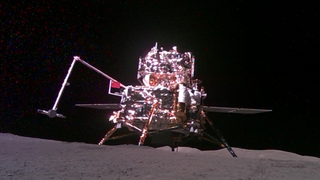
Chang’e 6 probe’s far-side moon samples enter return-to-Earth module in lunar orbit, China says (Image Credit: Space.com)
China’s Chang’e 6 mission continues to make history, having collected the first samples ever retrieved from the far side of the moon and now transferring those samples between spacecraft in orbit. That transfer was necessary for the next step in the samples’ journey — returning to Earth.
The successful rendezvous and docking of the Chang’e 6 moon probe’s ascender and its orbital module took place at 2:48 p.m. Beijing time (2:48 a.m. ET; 0648 GMT) on Thursday (June 6), according to the China National Space Administration (CNSA). The safe transfer of the lunar sample container was completed by 3:24 p.m. Beijing time (3:24 p.m. ET; 0724 GMT). This was the second time a CNSA spacecraft had achieved lunar orbit rendezvous and docking, with the previous example being Chang’e 5.
The latest CNSA mission is no stranger to making history. Chang’e 6 landed in the unexplored Apollo Basin crater, which sits within the larger South Pole-Aitken (SPA) Basin on the far side of the moon, on Sunday (June 2). That’s when it became only the second mission to successfully make a soft landing on the far side of the moon.
The previous mission to perform this tricky operation was the CNSA’s Chang’e 4 robotic lander and lunar rover — meaning, thus far, China is the only country to successfully make a soft landing on the far side of the moon.
Live footage of the Chang’e 6 docking procedure was published on the CNSA’s Weibo account and shared via the CNSA Watcher X feed.
“From the lunar orbit hardcore blockbuster! Chang’e 6 ascender and orbit return combination rendezvous docking and sample transfer video!” CNSA Watcher tweeted.
From the lunar orbit hardcore blockbuster! Chang’e 6 ascender and orbit return combination rendezvous docking and sample transfer video! Full HD:https://t.co/PVh2tLjLdm pic.twitter.com/FU4kruxhUlJune 6, 2024
On Weibo, the CNSA elained process behind the sample capture operation. After the Chang’e 6 rocket — which also carried the mission’s lander to the lunar surface — blasted off on Tuesday morning Beijing time (June 4) with samples in hand, it entered orbit around the moon. Then, it approached within around 9.3 miles (15 kilometers) of the Chang’e 6 orbiter.
The vast weight difference between the ascender, aka the sample-carrying rocket, and the orbiter meant great care had to be taken to avoid collision between the two vehicles during rendezvous and docking.
The CNSA added that the rendezvous and docking of the two spacecraft adopted a “handshake” and “hold tight” method that took around 21 seconds to complete. Just 1 second is used for the capture, 10 seconds are used to correct the alignment of the two spacecraft, and the final 10 seconds are used to lock the craft together.
“After completing the rendezvous and docking, the ascender will transfer the lunar soil sample,” the CNSA continued. “With the help of the transfer mechanism, the sample container will pass through a narrow channel of 200 to 300 millimeters wide and will eventually be captured by the returner.”
An animation is available on the CNSA YouTube channel that shows the whole procedure in detail.
After completing the sample transfer, the ascender was separated from the orbiter, the latter of which will continue to fly around the moon, waiting for the ideal window opportunity to transfer to an orbit around Earth. This waiting time around the moon is expected to last about 14 days, after which the orbiter will begin its moon-to-Earth transfer injection maneuver. Once orbiting Earth, the Chang’e 6 orbiter can dispatch the sample return canister, which is expected to drift back to Earth via parachute on June 25.
It is hoped that the intense study of these samples could help scientists solve lingering mysteries about the hemisphere of the moon that permanently faces out into space.
This will include potentially answering the question of why the near side of the moon is punctuated by vast and dark ancient flows of basalt lava called “lunar maria,” while maria are absent from the fine, dusty composition of the far side of the moon.






